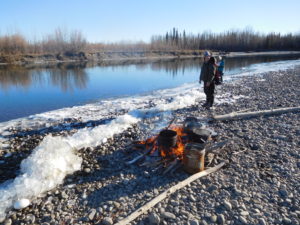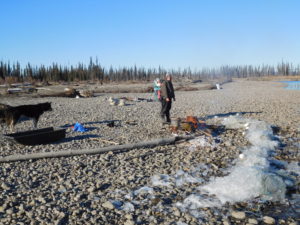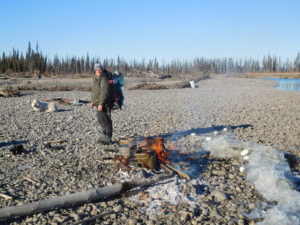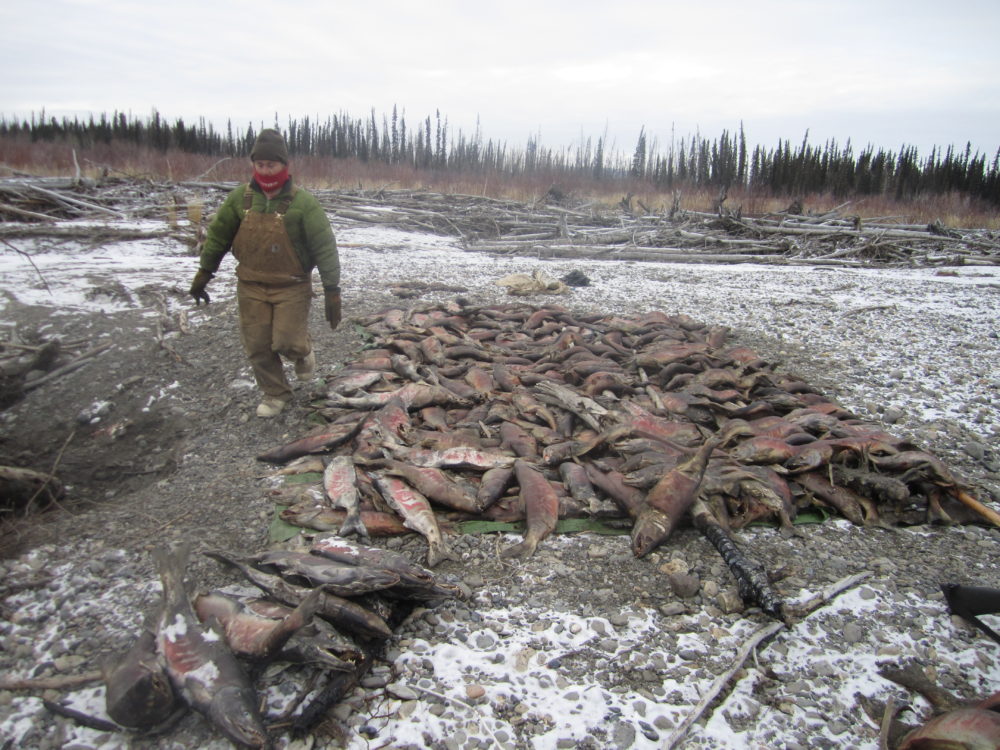We’ve been fishing for chum salmon with a 50 foot buoy net for 11 years now. You’d think we might have evolved to expert level, but we haven’t. This year we repeated an old mistake out of desperation during the slowest run we’ve ever seen in our time out in the woods. Fishing is serious business to us. We wouldn’t be running our trapline with a dog team if it weren’t for this important local food source. It would be cheaper for us to fly in fuel for a machine than buy and fly the amount of dog kibble we would need for the dogs without the fish for the dogs.
We started fishing in late September after our moose hunting was over and taken care of. We have a late run at our location being so far away from the ocean. A good catch this last fall meant getting 20 fish out of 2 nets in one day. Normal daily catches for us are usually in the 60-80 range for both nets. In the second week of October the weather started cooling down significantly until there was a foot of shore fast ice one morning when we checked the nets. We ignored the ice and reset the nets thinking it might not get worse in just one more night and we needed all the fish we could get. The next morning we approached one of the nets moaning and lamenting at our stupidity. The net was froze in completely. Underwater, the rest of the net was filling with a thick slush. We were skeptical that we could ever get the net back to shore in one piece. 50 feet of ice filled net is extremely heavy. We started to break ice and send it downriver away from the net. After struggling for a while we started to consider cutting the net into smaller sections in order to get it out of the river.We figured that by what we paid for the net 11 years ago that we averaged $30 a year for use of this net and that was a pretty good deal for all the fish it caught for us. It would basically be useless garbage out in the middle of nowhere if we cut it up so we decided to keep trying and hours later we finally had it hauled up to the edge of the shore. If we had cut it up we would have had to haul the heavy sections of net far enough from the river that they wouldn’t get swept away during spring breakup.
As the net has aged the netting has become more delicate and brittle over the years. We had already done major repairs after snagging it on numerous underwater trees over the years. We’ve had several close calls with underwater snags and unpredictable floaters coming downriver overnight. The net is so brittle now that the act of trying to crush the ice out of the webbing was punching substantial holes in the net. Once again we looked at our net with a ton of ice embedded in the netting and debated cutting it up and calling it a loss. If we cut it up in order to move it away from the rivers edge we would completely ruin the net. It would be irreparable. It’s hard not to have a prepper/hoarding mentality about tools and possessions in the bush. If we could get the net out intact it might not be too pretty anymore but it would be repairable and definitely useful in case of an apocalyptic situation. We started on one end of the net to get the net completely out of the water . In sections we would work together, one, two, three pull, one, two, three pull was our net saving rhythm we used to pull the net in. eventually we had all 50ft of it up on the rocks laying parallel to the river. Once we had it ashore we still had a lot of work to do.

The next day we packed a lunch and headed to the river to make a driftwood bonfire near our net. We brought along 4 5 gallon tin gas cans fitted with homemade wire handles to fill up and heat over the fire. We spent most of the day feeding the fire and heating up water over the fire in our buckets to pour over our melting net. little by little it lost some of its ice weight and we were able to move more of the net closer to the thawing fire. Once We had enough of the ice melted off to move it we put it in a sled and hauled it up to the cabin over the sandy beach to finish it’s last bit of thawing near the wood stove.

Funny thing is that just a few days after we saved the net from the ice it warmed up again and we put the nets back out because we had to. The run was so low we had to take our chance to fish again. For 2 more weeks after that we fished averaging only about 10 a day but every fish counted this last fall. It was October 29th when we finally had to take the nets in one last time. That is really late for the river to be wide open like that. We didn’t get any precipitation during that time either and the river just kept shrinking up by the day until you could wade across the river in many places and not get wet past your knees. The river was so narrow in places it didn’t seem like the river we know at all. We ended up with 289 fish, 200 fish shy of our goal. We worried about our dog food supply for the next two months. We had enough snow to start trapping in late November and by the end of December it was apparent that we would be able to catch enough lynx to supplement and keep the dogs fed well Until the end of the season.

Tyler and I don’t typically eat chum salmon. These fish have seen better days and the flavor is much to be desired. If you really spice them up they do ok if you need to eat them but I prefer other local fare much better like a fresh grayling, moose, and grouse. What is good to eat from the chum salmon is the roe, or fresh eggs. Most of the females we catch haven’t spawned yet and the eggs don’t age like the rest of the fish they stay fresh and delicious. I soak them in a salt brine, rinse them off and then hang them in some cheese cloth in the smokehouse for an afternoon and they are delicious on a cracker or with some rice.

me with grayling
It’s taken some time for us to figure out the perfect places to set our nets. When we first started out we had no idea what we were doing. We knew nothing about catching salmon with a net in the river. We had never observed anyone else participating in netting salmon before. Everything we were doing that first year was an interesting experiment for us. There was a lot to learn and no one was out there to teach us but fate and mother nature. I have the funniest memories of that first fall, images of us setting the net in the hardest places possible. It was a hard life we were choosing for ourselves so we assumed everything was going to be hard. We set the net where the river was running fast and deep and we are lucky we didn’t snag our net or lose it downriver in the heavy current. I don’t know why we thought the salmon would choose such a hard route to travel but we did. Eventually we gave up our dangerous struggle with the net in our unmotorized john boat and took the easy path in more tame slack water and voila the fish began hitting the net. The salmon run the easiest course and like to pull off the river into pockets of dead water to take breathers and spawn. Calm water is the key.
Since our run is so late in the season we usually have a convenient option for storing or “putting up” our fish for the dogs. We simply walk them to a place on the gravel bar where the rocks are fairly large and washed clean by the river and lay them down to freeze. We don’t want them to freeze down to sand or small rocks because it would be hard to remove that debris after they are frozen and we don’t want dirt, sand, and small rocks going into our dogs stomachs. As soon as we have enough snow we sled them all up in one day to our cabin where we keep them in a fenced in enclosure so the dogs can’t help themselves when they are running loose which they often are. We’ve spent long hours splitting and drying the fish before but have found that the dogs find the whole fish much more palatable. The other benefit to leaving the fish whole is you don’t lose any nutrition or moisture from the fish. The moisture left in the fish is good for the dogs. Also when you split the fish you can lose most of the egg sacks which are fatty and packed with calories and nutrition for the dogs as well. The dogs have a lot more trouble digesting the bony dried up fish. Dried fish is somewhat convenient for traveling with in the dogsled on trips as it is light weight but overall not worth it to us. Whole frozen fish are much more convenient to chop up with an ax than a funny shaped crispy dried fish.
I wonder and worry about what the run will be like this coming fall. Far less breeding fish made it up the river last fall. If we ever lose our fish we will likely have to quite running dogs. …
Well our store on my alaskaseldens.com site is now open for business and we are already considering dropping some prices for faster sales. Its hard with some items like the bone chimes because there is such considerable time that goes into artsy items like that from the harvest of the animals to the cleaning and the bleaching of the bones, claws and teeth but it’s art and that is why they say most artists starve. Please be sure to at least checkout the marten baculum earrings, they are really cool, a marten penis bone.

It looks really cold out by the river. Was the Last Alaskan film crew there at that time?
Thanks for the update and stay safe.
No film crew this past season…season 5 to be determined.
That would be a real bummer, so many people are attached to you all and your lifestyle through the show. Do you know if they filmed other folks from the show for a season 5?
No filming whatsoever…no one.
I cant figure out your website. Would like to see what you have for sale
Hmmm yeah I just tried to get to the direct link…alaskaseldens.com/shop but it says it can’t be reached …so the only way to access it that I know of till I get someone to help me figure this out is to go to my main page at alaskaseldens.com and click the shop button option at the top of the page
Hi Kathy, so if you go to my main page by typing in the alaskaseldens.com address there is a list of pages at the top of the main page on of those is a clickable shop page. I sure hope that works for you …perhaps you are viewing from a small screen? and you don’t get the entire picture?
Hi Ashley, I had a total hip replacement today and due to the anesthesia I can’t sleep (believe it or not). Was so excited when I opened up Facebook tonight to find your blog. Made my horrible day… Love all that you do and don’t know how you have the time but I have a question regarding the fish and the dogs. I was always told never to give my dogs chicken bones or fish bones and I was wondering how they eat them with outchokong or getting stuck in their throat. Probably a stupid question but I was just confused. Continue when you have time to do your blog it interests everyone who reads it. You and Tyler have to be Soulmates. You are both so lucky to have find each other in this large large world. Take care and continue to love each other.
We run a very old and hardy breed of dogs they digest almost all bones very well…except for lynx bones which are very strong and sharp so avoid those.
I LOVE my Marten teeth earrings!!! It makes me feel just a little connected to your interesting life!!
Thanks again for your support Pamela!!!!
Hope the Salmon run improves , but a snow machine may be a good investment as a backup , a may less work & faster. Would something that big have to be brought in by plane/boat? We all enjoy your lifestyle & stories! Thanks for sharing! Set a personal record trapping! Your Friend, Harry C. Risher.
We are always going back and forth about switching to snow machines…always a conversation that comes up multiple times a year but both forms of transportation come with its own list of costs and benefits and I hope to write about that list of comparisons sometime. Congrats on your trapping!
Wow, this story was amazing to think of how much effort went in to recovering your frozen net!!! Amazing! Oh, by the way, I received the lynx skull I ordered & love it!! It’s found a perfect spot in my husband’s office & I displayed your picture with it. 😁
Thank you so much for supporting this lifestyle.
Awesome post, Ashley. Thank you for the update. Sorry to hear that the salmon run was less than ideal for you. Question: how was your trapping season?
I will get to the trapping season….soon.
I enjoy your tv show very much and look forward to seeing new episodes soon. also look forward to seeing how much your daughter has grown.
We haven’t filmed a season 5 yet…there was no filming this last year so if we get a season 5 it is going to be a while! Thank You for reading
I can’t find your site for your items for sale?
The shop is a clickeable option on the main page of this website…perhaps you are viewing on a small screen like a phone and you don’t get the entire site image?
I was wondering if you are catching spawning fish isn’t that depleting the fish population for the next year? Just curious.
We are the only people to fish for chums on the entire river we live on…298 fish is pretty unsubstantial considering that. Fish and wildlife has been doing areal counts in the fall over our river on and off through the last 5 years after a counting station closed down at the mouth about 10 years ago. It’s really hard to tell what will happen next year, it might be really good fishing? We record and report numbers and sex counts for fish and game and we are more than willing to close down our activity if the future of our salmon were in trouble. We will be paying attention!
Ashley you are a natural storyteller, the detail describing the salmon net incident was interesting with excellent detail. You should seriously consider maintaining a diary of your day to day activities out in the wilderness and consider publishing it. I know the fans of the Last Alaskans would be buyers.
I do keep a journal and I definitely plan on doing much more detailed and heavy writing projects when my kids are a little bigger and need less mommy time.
Thanks for the article. The show becomes more appreciated after words from you…
I cook with powdered milk and now I buy organic whole powdered milk for Sydney which is really expensive. We do bring some powdered eggs…enough to do baking as for scrambling them we can’t agree, we don’t like their taste. Also powdered cans of eggs are heavy and expensive, not a product worth us having at hand to use at leisure. The cost and planning of what foods we choose to have out there for over half a year of use is complicated.
You can preserve eggs by using hydrated lime from the local hardware store, not the garden one. They will last up to 2 years in a cool place. Also putting mineral oil on them they will last 6 months or more. These eggs need to be fresh, unwashed eggs. Also you can try salt cured egg yolks. Good luck. 🙂
Definitely great folk wisdom but whole eggs are definitely too bulky and heavy to have on the trapline. We are so limited in what we take up there I can’t emphasize this enough. I think I need to write about it to paint the proper picture and budget for people.
No film crew ?? SAD .. One of the best shows on tv. How can we help ? Who can we call ?If you prefer no film crew and to be alone I can understand that too. God Bless to all… Thanks
Most likely there will be a season 5 with filming starting in the fall but not set in stone yet. We got a year off and we probably needed that. Someday when it is for sure all over I plan on writing about the tv experience we had but not allowed yet.
Did you have another baby?
I am due with # 2 2nd week of May!
So from your comments there will be NO new shows this fall/winter with Heimo/ Edna or Charlie either ?
correct, no filming with any of us.
What else do you feed the dogs to help extend your supply of fish? Many blessings to you and your family.
We feed the dogs all of the lynx carcasses that we don’t eat ourselves. Also pure tallow and a bit of commercial dog feed…10 bags throughout the entire winter. The commercial feed we buy is called Caribou creek and we think is it the highest quality dog food around.